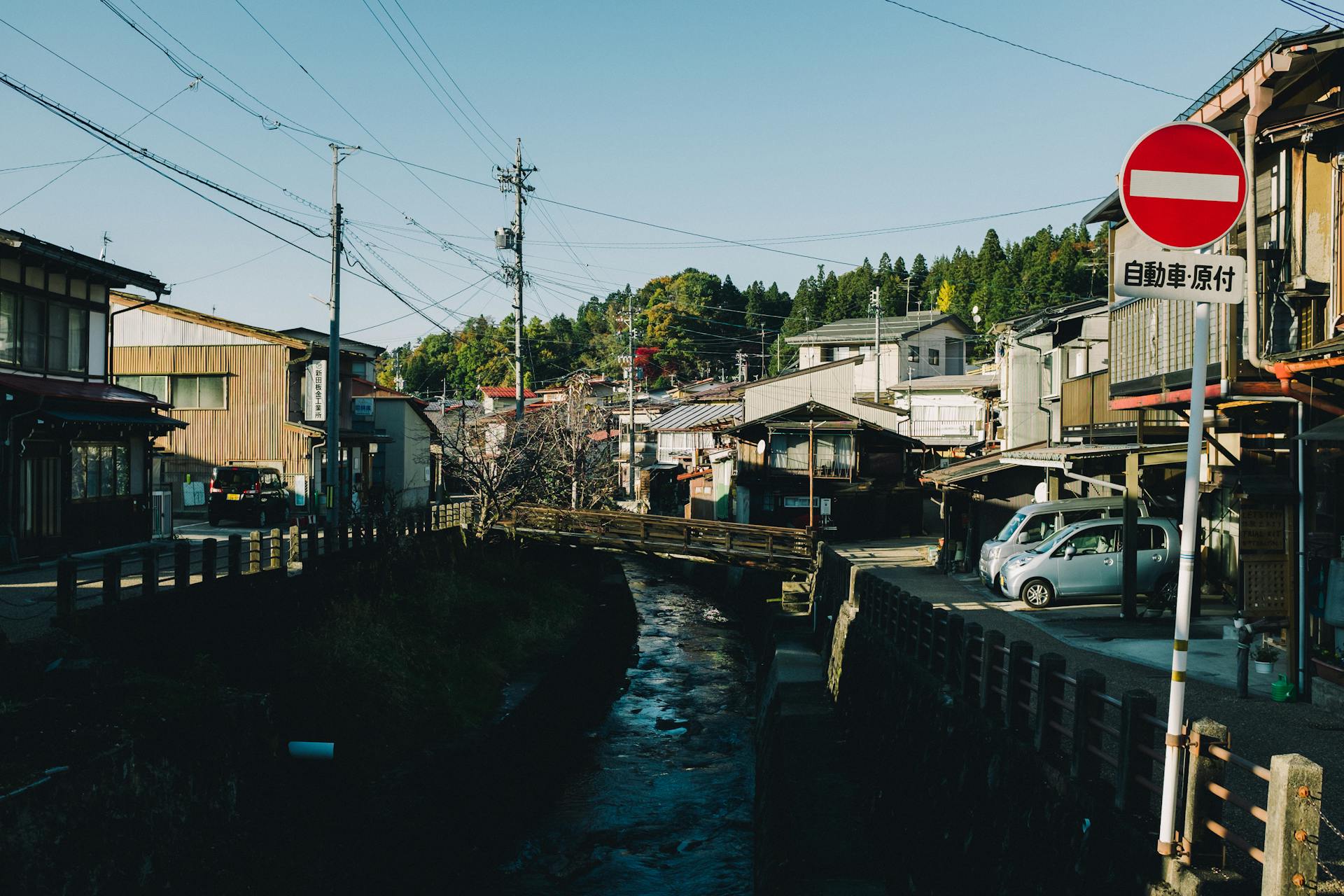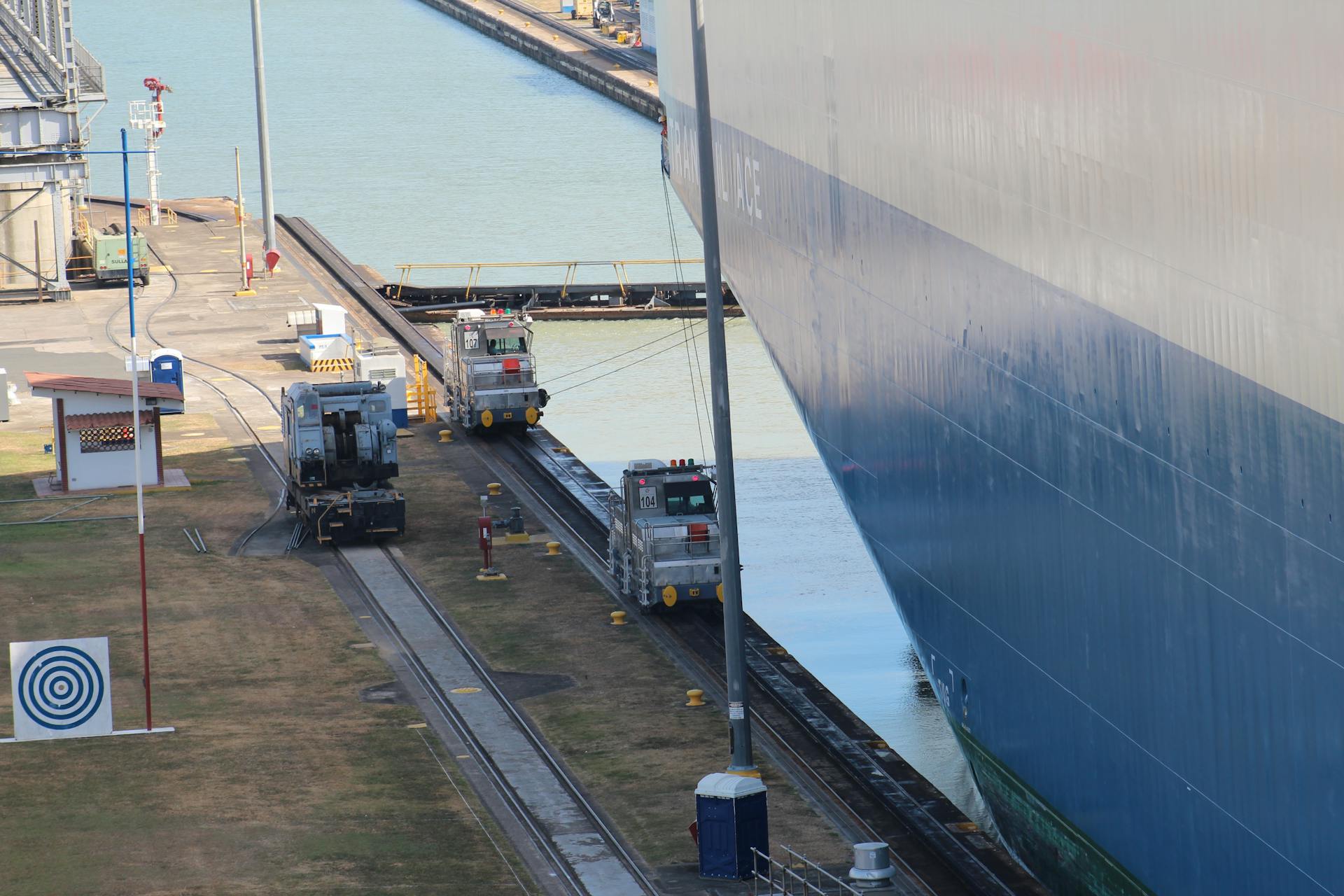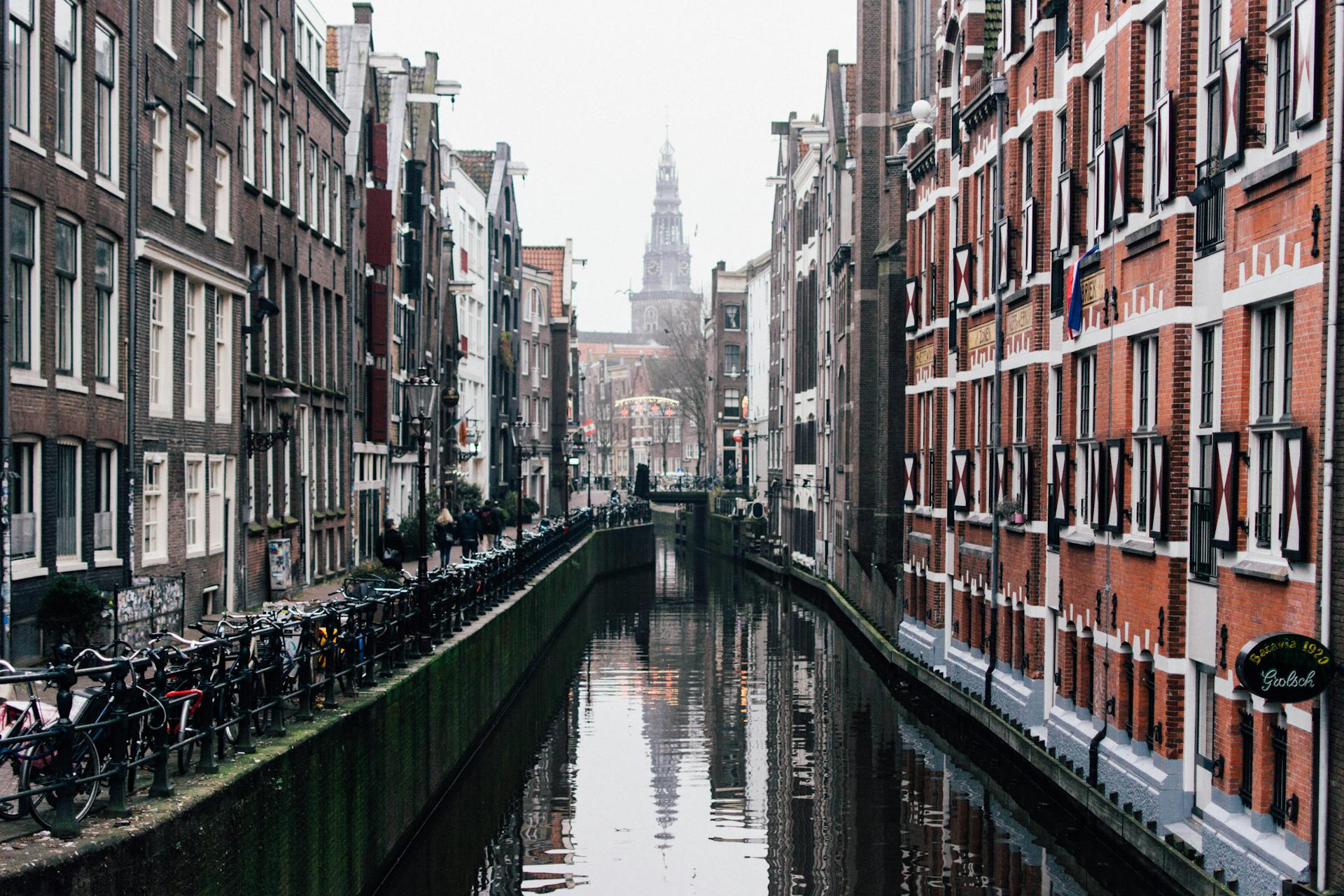
The Germany Kiel Canal is a vital waterway that connects the North Sea to the Baltic Sea, stretching 61 miles from Kiel-Holtenau to Brunsbüttel. It's a crucial shipping route for Germany and Europe.
The canal was opened in 1895 and has undergone several expansions and modernizations since then. Today, it's one of the busiest waterways in the world, with over 40,000 vessels passing through each year.
The Kiel Canal is a remarkable feat of engineering, with a maximum depth of 39 feet and a maximum width of 525 feet. It's a testament to the ingenuity of the engineers who designed it.
The canal's annual traffic includes a mix of cargo ships, tankers, and cruise liners, with the majority carrying goods such as oil, coal, and containers.
Choosing the Kiel Canal
Navigating through the Kiel Canal saves approximately 243 NM compared to the route through the Danish Straits.
The Kiel Canal is a more time-efficient route, allowing you to save time and fuel.
You'll also have good protection from storms that can be a problem around the Jutland Peninsula.
Navigating the Kiel Canal
Navigating the Kiel Canal is a straightforward process, but it's essential to follow the rules to ensure a safe and smooth passage.
To enter the canal, look for an intermittent white light in front of the lock, which signals that it's safe for yachts to enter. This light is your cue to proceed.
When approaching the canal, be aware that three flashing red lights in the siding mark a no-entry zone, even for pleasure craft. This is because large vessels are approaching, and it's essential to give them priority.
As you navigate the canal, remember to stay on the right-hand side and keep a safe distance from the bank, as stipulated by the signs.
Signs and Signals
As you navigate the Kiel Canal, it's essential to understand the various signs and signals that guide you through the waterway. An intermittent white light in front of the lock signals your entry, while all other combinations with red or green are reserved for commercial shipping.
Keep an eye out for three flashing red lights in the siding, which mark a no-entry zone even for pleasure craft. This is because very large vessels are approaching, and it's crucial to give them the right of way.
You'll need to travel on the right side of the canal, with signs sometimes stipulating minimum distances from the bank in metres. This ensures a safe and smooth passage for all users.
13 Practical Tips
As you navigate the Kiel Canal, here are some practical tips to keep in mind:
Plan your trip during the summer months, as the canal is closed from mid-October to mid-April due to ice.
The canal's width and depth vary, ranging from 98 to 107 feet and 28 to 30 feet respectively, so be prepared for different navigational conditions.
Make sure to check the canal's current and tide tables to ensure a smooth passage.
The Kiel Canal is a busy waterway, with over 60,000 vessels passing through it every year, so be prepared for traffic and delays.
The canal's maximum speed limit is 12 knots, so pace yourself and don't rush through the passage.
Be aware of the canal's shallow spots, particularly near the locks, where the water is only 18 feet deep.
Take advantage of the canal's many locks, which can raise or lower your vessel up to 36 feet in just a few minutes.
Be mindful of the canal's many bridges, which can be raised to allow vessels to pass underneath.
The Kiel Canal is a popular route for both recreational and commercial vessels, so be prepared for a variety of different types of boats and ships.
Consider hiring a local guide or pilot to help navigate the canal, especially if you're not familiar with the area.
Take breaks and enjoy the scenic views along the canal, which offer stunning vistas of the surrounding countryside.
Be prepared for changing weather conditions, as the canal's microclimate can be unpredictable.
The Kiel Canal's emergency services are well-equipped to handle any situation, so don't hesitate to seek help if you need it.
Entry/Exit
As you navigate the Kiel Canal, you'll need to be aware of the various entry and exit points.
The Kiel Canal has a total of 49 bridges, many of which are automatic, allowing for seamless passage.
Make sure to check the schedule for the locks, as they operate on a fixed timetable to avoid congestion.
The canal's maximum allowed draft is 13.5 meters, so be mindful of your ship's height and depth to avoid any issues.
You'll find four main locks along the canal, each with its own unique characteristics and capacities.
Other Rules
Navigating the Kiel Canal requires attention to specific rules that ensure a safe and enjoyable experience for all users.
Keep to the right at all times to avoid collisions and congestion.
Maximum speed limits are in place to prevent accidents and protect the environment. The maximum speed allowed is 8kts (15km/h) over ground.
Recreational craft may set sails, but a black cone pointing down must be displayed as a warning to other vessels.
Waterskiing, jet biking, and windsurfing are prohibited to minimize the risk of accidents and damage to the canal.
In case of fog, vessels can moor at a suitable site if it's unsafe to continue to the next siding.
Recreational craft with a length of 20m or more must operate an AIS Transponder to enhance safety and communication.
Towing is allowed, but only one recreational craft with a length not exceeding 15m can be towed by a powered recreational craft.
Here are some key rules to remember:
Locks and Bridges
The Kiel Canal in Germany is a significant waterway that requires secure locks to manage the transition between the Baltic Sea and the North Sea. The canal's locks are designed to lift ships up to 24 meters in just 30 minutes.
The locks are equipped with massive gates that can be opened and closed quickly to allow ships to pass through. These gates are made of steel and are over 30 meters long.
The Kiel Canal also features several bridges that span the waterway, providing a vital connection between the two seas.
Holtenau Lock
The Holtenau Lock is a must-know for any sailor approaching Kiel, Germany.
You'll need to wait in the designated waiting area, marked by a red triangle on the map, before proceeding to the lock.
Approach the lock on VHF channel 12, where you'll receive any additional instructions or clarification from the lockmaster.
It's essential to tie up to the jetty once you've entered the lock, and be mindful of the low wooden jetties - make sure your fenders are on the water level to avoid any issues.
A horn will sound to signal that the gate is closing and the water level is dropping, followed by another horn blast indicating the exit gate is opening and you're clear to proceed.
A fresh viewpoint: Caledonian Canal Centre & Lock Chambers
Brunsbüttel Lock
The Brunsbüttel lock is a key exit point from the Kiel Canal, leading into the Elbe River. To transit the lock, you'll need to time your passage with favorable currents in the Elbe river.
Take a look at this: Hamburg Germany River
Leaving the Kiel Canal via Brunsbüttel lock requires careful planning. Recreational craft waiting areas are marked in red on the chartlet, but keep in mind that space is limited and rafting with other boats may be necessary.
The Brunsbüttel recreational craft berth on the North side of the locks is a convenient place to stop and wait for a favorable current. You'll be moored close to the large locks with constant commercial vessel traffic, so be prepared for noise.
Rendsburg Transporter Bridge
The Rendsburg transporter bridge is a unique structure that serves as both a transporter bridge and a railway viaduct. It opened to traffic in 1913 and continues to carry traffic to this day.
The bridge has a clearance of 42 m, but the ferry that runs underneath it hangs lower. This has led to many collisions between the ferry and passing vessels.
The ferry runs daily, every 15 minutes, from early morning until late at night. This frequent schedule is likely necessary to accommodate the high volume of traffic on the canal.
Payment and Fees
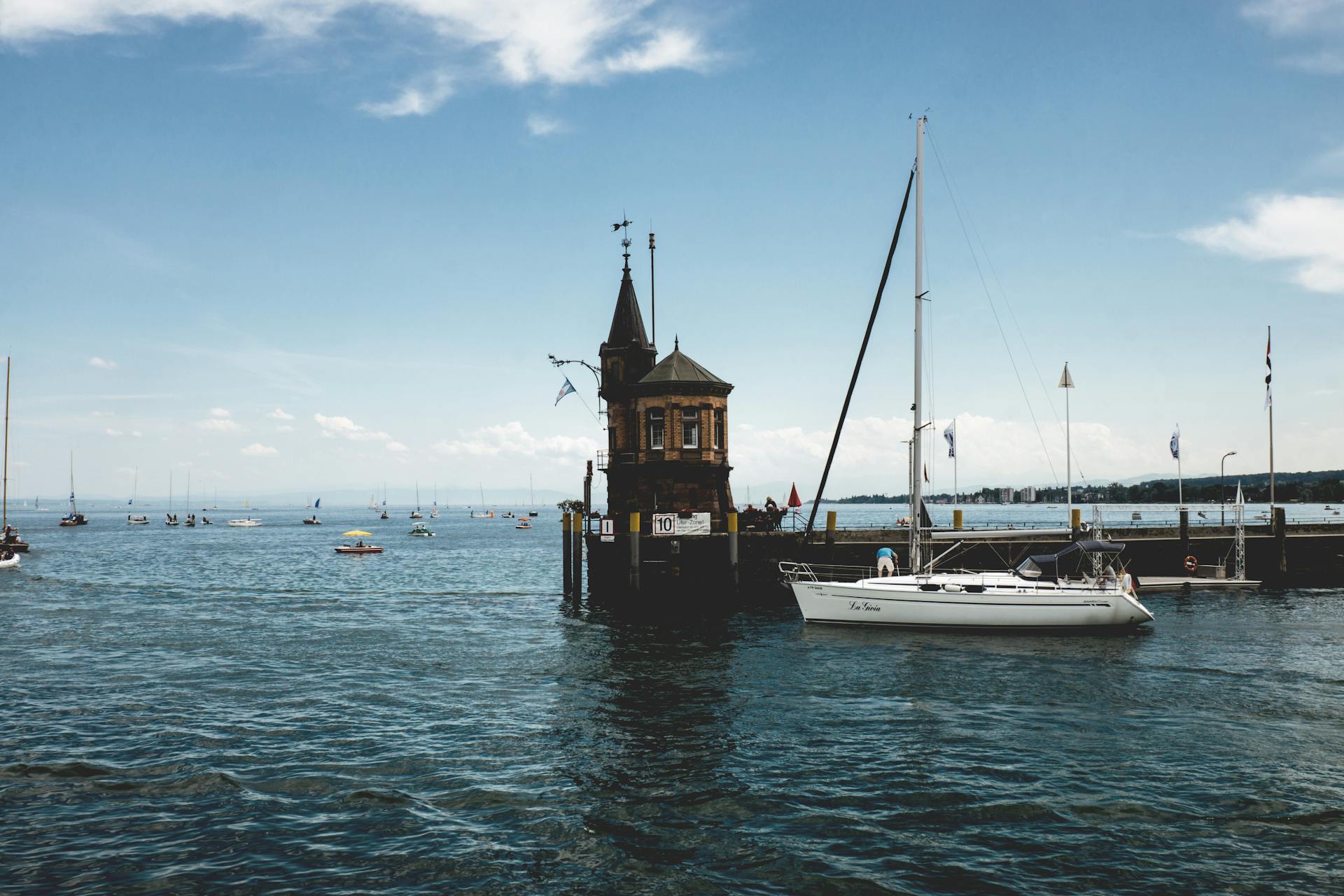
The Kiel Canal transit fees for recreational craft are quite reasonable, with costs ranging from €12 to €43, depending on the length of your vessel.
You can pay for Kiel Canal transit at payment machines or designated harbor masters, making the process pretty straightforward.
Here's a breakdown of the current Kiel Canal transit fees:
From March 2023, you can also pay your fees in advance online for sailing, making it even easier to plan your trip.
Marinas and Services
If you're planning to navigate the Kiel Canal, you'll want to know about the marinas and services available along the way.
There are two marinas near Rendsburg, one of which is run by the local sailing club Regatta Verein Rendsburg and offers all the facilities you need.
A well-protected marina for leaving your boat for a longer period of time can be found near downtown Rendsburg, with the harbour master available to negotiate the details.
You can also stop by the Borgdtedter Enge marina, which is located at Km 67.5 on the north side and offers fuel on the pontoon.
Shops are conveniently located in the small village of Borgstedt, making it a great spot to restock and refuel.
The marinas near Rendsburg are a great place to stop and take in the sights, with the local sailing club's yacht harbour being a popular spot for tourists and yachties alike.
If you're looking for a museum visit, the canal museum in Brunsbüttel is a must-see, offering insights into the construction, history, and technology of the canal.
However, be aware that the harbour in Brunsbüttel can be a bit restless at night due to the nearby lock's 24-hour operation.
Here are some key marinas to keep in mind as you navigate the Kiel Canal:
- Regatta Verein Rendsburg yacht harbour (near downtown Rendsburg)
- Borgdtedter Enge marina (Km 67.5, north side)
History
The Kiel Canal has a rich history dating back to 1784 when the 43-kilometer Eiderkanal was completed by Denmark's King Christian VII. This precursor canal was part of a 175 km waterway from Kiel to the Eider mouth at Tönning.
The Eiderkanal was quite limited, with a width of only 29 meters at the surface and a depth of just 3 meters, making it insufficient for the growing size of ships. It could only accommodate vessels of up to 300 tons.
In 1887, work began on a much larger canal, which was later completed in 1895. The foundation stone was laid by Emperor Wilhelm I on June 3rd, 1887, marking the start of this massive project.
The new canal was a game-changer, stretching 98.7 kilometers long and connecting the North Sea at Brunsbüttel to the Baltic Sea at Kiel-Holtenau. It was inaugurated by the German Imperial Yacht "Hohenzollern", with Emperor Wilhelm II on board.
The canal was later widened between 1907 and 1914, making it an even more vital transportation route for ships. Up to 8,900 workers were employed during the construction of the canal, which took around 8 years to complete.
Ferries and Transport
The Kiel Canal is a vital transportation route that connects the North Sea to the Baltic Sea, and ferries play a significant role in this process. With a length of approximately 61 miles, it's the busiest waterway in the world.
One of the most notable ferry routes is the one between Kiel and Puttgarden, which is operated by Fehmarnbelt Ferry. The ferry ride takes about 45 minutes.
The Kiel Canal is also an important route for cargo ships, with over 60,000 vessels passing through it every year. This includes ships carrying goods like petroleum products, chemicals, and containers.
The canal is a key transportation artery for Germany's economy, with many industries relying on it to transport their goods.
Sailing and Safety
The Kiel Canal is one of the busiest waterways in the world, with over 60,000 ships passing through it every year. This high volume of traffic requires strict safety protocols to be in place.
Navigation through the canal is governed by strict rules, including a maximum speed limit of 12 knots. This ensures that ships can safely navigate the narrow and winding waterway.
To minimize the risk of accidents, the Kiel Canal is equipped with advanced navigation aids, including depth sounders and electronic chart display and information systems.
What to Look Out for
As you prepare for your sailing adventure, it's essential to be aware of the potential hazards that can arise. Weather conditions can change rapidly, so keep a close eye on the forecast and be prepared to adjust your plans accordingly.
Be mindful of the wind direction and speed, as strong gusts can catch you off guard. A wind speed of 20 knots or higher can be challenging for even experienced sailors.
Always check the weather forecast before setting sail. A sudden change in weather can lead to rough seas, making it difficult to navigate.
Take a look at this: Bremerhaven Germany Weather
The ocean can be unpredictable, and it's crucial to be prepared for emergencies. Always carry a first aid kit and a communication device on board.
Make sure to check your equipment regularly to ensure it's in good working condition. A faulty life raft or broken navigation light can be a disaster waiting to happen.
Be aware of your surroundings and keep an eye out for other vessels, buoys, and obstacles in the water. A collision can be avoided by staying vigilant and following safety protocols.
Fuel Types
Let's talk about fuel types for your sailing adventure. Propane is a popular choice for cooking and heating on sailboats because it's relatively safe and efficient.
Propane has a low boiling point, making it easy to use in a variety of applications, including stoves and heaters. This is especially important on a sailboat where space is limited.
Diesel fuel is often used in sailboat engines because it's a reliable and long-lasting option. Diesel engines can run for hundreds of hours without needing a refill.
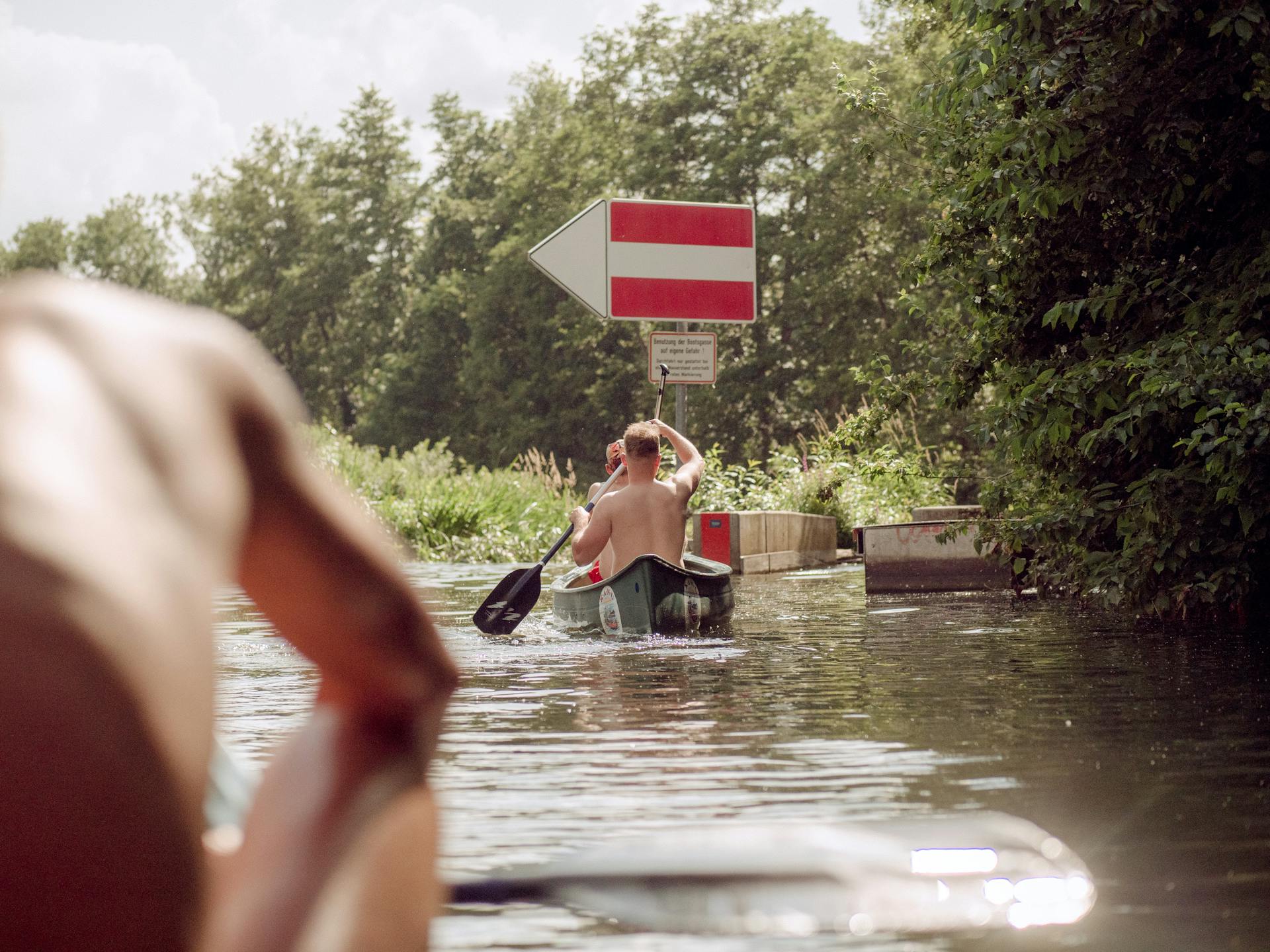
However, diesel fuel can be more difficult to handle and store than other types of fuel. This is because it's a heavier liquid that can be messy to work with.
Gasoline is another option for sailboat engines, but it's not as common as diesel fuel. Gasoline engines are typically lighter and more portable than diesel engines.
It's worth noting that gasoline is a more volatile fuel than diesel, which can make it more prone to leaks and spills. This is something to consider when choosing a fuel type for your sailboat.
Cargo and Types of Ships
The Kiel Canal is a vital shipping route in Germany, and understanding the types of ships that pass through it is essential to appreciating its importance.
The Kiel Canal is approximately 61 miles long and has a minimum depth of 27 feet, allowing for a wide range of cargo ships to navigate its waters.
Bulk cargo ships are a common sight on the Kiel Canal, transporting goods such as coal, grain, and other dry bulk materials.
Tanker ships are also frequent visitors, carrying oil and other liquids to destinations along the canal.
General cargo ships, which can carry a variety of goods including containers, vehicles, and project cargo, are another type of ship that uses the Kiel Canal.
The Kiel Canal is an important route for cruise ships, which offer passengers a unique perspective on the region's history and culture.
The canal is also used by cargo ships carrying oversized and heavy project cargo, such as wind turbines and construction equipment.
Port Information
The Kiel Canal is a major shipping route in Germany, and understanding its port information is essential for navigating the waterway.
The Kiel Canal has two main ports, Kiel and Brunsbüttel, which are connected by a 98-kilometer-long canal.
Both ports offer a range of facilities and services for ships, including fueling stations, repair yards, and cargo handling equipment.
Kiel is a popular port for passenger ships and cruise liners, with many offering scenic tours of the canal.
Curious to learn more? Check out: Hamburg Germany Cruise Port
Brunsbüttel, on the other hand, is a major cargo port, handling a significant amount of freight traffic each year.
The Kiel Canal is also an important route for oil tankers and other large vessels, which use the canal to travel between the Baltic Sea and the North Sea.
The canal's port information is managed by the German Waterways and Shipping Administration, which oversees all aspects of navigation and safety on the waterway.
Frequently Asked Questions
Is the Kiel Canal still used?
Yes, the Kiel Canal remains one of the world's busiest artificial waterways, connecting the Baltic countries to the global market. It continues to play a vital role in international trade.
What is the Kiel Canal famous for?
The Kiel Canal is the busiest artificial waterway in the world, connecting the North Sea to the Baltic Sea. It's a vital shipping route that has remained largely unchanged since the end of World War II.
How long does it take to go through the Kiel Canal?
The Kiel Canal can be sailed through in 6 to 8 hours. This journey time allows for a relatively quick passage through the canal.
Sources
- https://blog.noforeignland.com/kiel-canal-transit-with-a-sailboat/
- https://www.kiel-canal.de/history/
- https://www.thetravel.com/visit-germanys-kiel-canal/
- https://dan-bunkering.com/ports/kiel-canal-germany/
- https://www.yacht.de/en/travel-and-charter/germany/kiel-canal-the-ultimate-nok-guide-for-sailors/
- https://www.cruiserswiki.org/index.php
Featured Images: pexels.com
